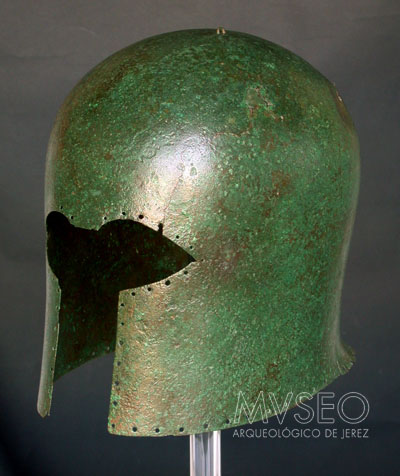GREEK CORINTHIAN HELMET
Protohistory
GREEK CORINTHIAN HELMET
Hammered bronze.
Height: 22.5 cm. Width: 16.5 cm. Maximum diameter: 22 cm.
Protohistory. Early 7th century B.C.
Origin
Guadalete River. Jerez de la Frontera. Cádiz.
Description
One of the oldest Greek items found in the West. The adjective 'Corinthian' is not indicative of the piece's origin, it merely refers to the shape that was most popular among Greek helmets in the Archaic and Classic periods, independent of the place of manufacture. Due to its formal characteristics: markedly vertical proportions in which only one small curve covers at the crown at the back, the uniform thickness at the walls and lack protection of the nasal area, it is considered to be one of the most ancient examples of its kind. It is made from a single sheet of bronze beaten by hammer. It would have covered the entire face, leaving slits for the eyes. Judging by the ring conserved on the upper part, it must have had a crest. Around the edge is a line of perforations, which would have been used to attach a protective leather cover. It was discovered by accident in 1938 on the banks of the Guadalete River, near the ancient estuary. This connection to a watercourse is also seen in the case of the Greek helmet from Huelva and other weapons from the Late Bronze Age such as the Bornos sword. Some researchers have interpreted this as an indication of ritual activities linked to river gods. In this sense, the hole that can be seen in the lateral area appears not to have been caused in battle, which is the traditional theory. Instead, a deliberate lack of use could have affected the loss of the nasal part, just like in helmets presented as offerings in Hellenic temples.
Bibliography
- Pemán, C. (1938): Hallazgo de un casco griego en el Guadalete y recapitulación de los testimonios sobre la presencia de los griegos en Andalucía en los siglos VII-V. Cádiz 1938.
- Esteve Guerrero, M. (1979): “El casco griego de Jerez”. Miscelánea Arqueológica Jerezana. Jerez de la Frontera, pp.19-25.
-Olmos Romera, R. (1986): “Los griegos en Tarteso: replanteamiento arqueológico-histórico del problema”. Homenaje a Luis Siret (1934-1984). Sevilla, pp. 588-589.

